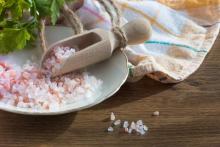Salt 101: The Best Salts for Your Health
As a society, we are constantly bombarded by conflicting information as to what is “good for us” to eat—and what is not.
For example, a pervasive myth exists that “salt is bad.” While an excess of salt in the diet can be harmful, and in some cases a person may need to monitor salt intake based on certain health conditions—it is important that we don’t throw out salt altogether. Salt is actually an incredibly important element of our diet that we require to function, feel good and thrive on a daily basis.
The key here, of course, is moderation.


